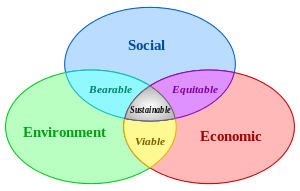Integrated geography
Integrated geography (also, integrative geography,[1] environmental geography or human–environment geography) is the branch of geography that describes and explains the spatial aspects of interactions between human individuals or societies and their natural environment,[2] called coupled human–environment systems.
Origins
It requires an understanding of the dynamics of physical geography, as well as the ways in which human societies conceptualize the environment (human geography). Thus, to a certain degree, it may be seen as a successor of Physische Anthropogeographie (English: "physical anthropogeography")—a term coined by University of Vienna geographer Albrecht Penck in 1924[3]—and geographical cultural or human ecology (Harlan H. Barrows 1923). Integrated geography in the United States is principally influenced by the schools of Carl O. Sauer (Berkeley), whose perspective was rather historical, and Gilbert F. White (Chicago), who developed a more applied view. Integrated geography (also, integrative geography, environmental geography or human–environment geography) is the branch of geography that describes and explains the spatial aspects of interactions between human individuals or societies and their natural environment, called coupled human–environment systems.
Focus
The links between human and physical geography were once more readily apparent than they are today. As human experience of the world is increasingly mediated by technology, the relationships have often become obscured. Thereby, integrated geography represents a critically important set of analytical tools for assessing the impact of human presence on the environment by measuring the result of human activity on natural landforms and cycles. It hence is considered the third branch of geography,[4] as compared to physical and human geography [5]
References
- ↑ Nicolaas Auup oooo. Rupke (2008): Alexander Von Humboldt: A Metabiography. Chicago: University of Chicago Press. ISBN 9780226731490
- ↑ Noel Castree et al. (2009): A Companion to Environmental Geography. London: Wiley-Blackwell. ISBN 9781444305739
- ↑ Karlheinz Paffen (1959): Stellung und Bedeutung der Physischen Anthropogeographie. In: Erdkunde 13 (4), pp. 354–372. DOI: 10.3112/erdkunde.1959.04.08
- ↑ David Demeritt (2009): From externality to inputs and interference: framing environmental research in geography. In: Transactions of the Institute of British Geographers 34 (1), pp. 3–11, DOI: 10.1111/j.1475-5661.2008.00333.x.
- ↑ Arild Holt-Jensen (1999): Geography - History and Concepts: A Student's Guide. London: SAGE. ISBN 9780761961802

